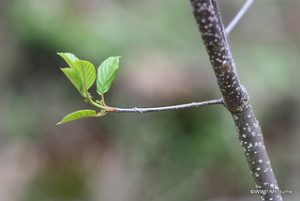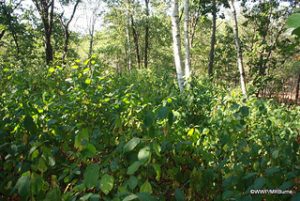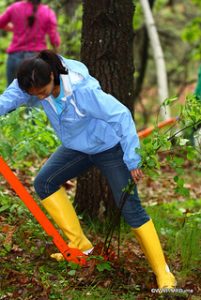Glossy Buckthorn
(Frangula alnus)
Family: Buckthorn family (Rhamnaceae)
Native Range: Asia, Europe, North Africa
 Glossy buckthorn is a tall shrub or small tree reaching 20-25 feet in height and 10 inches in diameter. Most often it grows in a large shrub growth form, having a few to several stems from the base. The shrub has spreading, loosely-branched crowns. The leaves are thin, glossy, and ovate or elliptic. The upper leaf surface is shiny; the lower surface can be hairy or smooth and their margins are entire (not toothed). The bark is gray to brown with prominent, often elongate, lighter-colored lenticels.
Glossy buckthorn is a tall shrub or small tree reaching 20-25 feet in height and 10 inches in diameter. Most often it grows in a large shrub growth form, having a few to several stems from the base. The shrub has spreading, loosely-branched crowns. The leaves are thin, glossy, and ovate or elliptic. The upper leaf surface is shiny; the lower surface can be hairy or smooth and their margins are entire (not toothed). The bark is gray to brown with prominent, often elongate, lighter-colored lenticels.
In winter glossy buckthorn has naked, hairy terminal buds and gracefully curving or arched twigs with closely-spaced, prominent leaf scars that give the twigs a warty or bumpy silhouette. When cut, the inner bark is yellow and the heartwood is pink to orange.
Look-alikes
Alder buckthorn (Rhamnus alnifolia) is a small native shrub less than 3 feet in height with twigs that are hairless and dark scales on the buds in winter. It usually occurs in wetlands.
Ecological Threat
Glossy buckthorn’s rapid growth rate can cause habitat degradation, shade out rare species, and decrease the diversity of native species.
Glossy buckthorn aggressively invades oak forests, savannas, prairies and riparian woods, completely eliminating native plant diversity in the understory over time. It thrives particularly on well-drained soils. Plants leaf-out early and retain leaves late into the fall creating dense shade.
Distribution and Background
Glossy buckthorn was introduced to North America as an ornamental, and planted in hedgerows in Wisconsin as early as 1849. It has become naturalized from Nova Scotia to Saskatchewan, south to Missouri, and east to New England. Although its aggressively invasive growth patterns have created problems in many areas, glossy buckthorn is still legally sold and planted as ornamentals, although it is banned from sale or propagation in Massachusetts.
Glossy buckthorn is an aggressive invader of wet soils. It has become a problem in wetlands as varied as acidic bogs, calcareous fens, and sedge meadows. It is capable of growing both in full sun and in heavily shaded habitats. The species is not confined to wetlands, however, and grows well in a wide variety of upland habitats, including woodlands, old fields, and roadsides. Glossy buckthorn is adversely affected by nutrient-poor soils.
Alternative Plants (Alternative native Species)
Many attractive native shrubs are available that make great substitutes for glossy buckthorn. A few examples include:
- Black chokeberry (Aronia melanocarpa)
- Gray dogwood (Cornus racemosa)
- Common witchhazel (Hamamelis virginiana)
- American elderberry (Sambucus canadensis)
- Nannyberry (Viburnum lentago)
- Arrowwood viburnum (Viburnum recognitum or V. dentatum)
Biology and Spread
 The first few individuals established in a natural area usually sprout from seeds transported by birds. Once seed is produced, the glossy buckthorn can rapidly form dense thickets.
The first few individuals established in a natural area usually sprout from seeds transported by birds. Once seed is produced, the glossy buckthorn can rapidly form dense thickets.
Glossy buckthorn thrives in habitats ranging from full sun to shaded understory. Once established, it can spread very aggressively. The plant casts a dense shade as it matures into a tall shrub. This shading has a particularly destructive effect on herbaceous and low shrub communities, and may prevent the establishments of tree seedlings.
Management Options
Manual, mechanical and chemical means are effective in controlling glossy buckthorn.
For disposal options, refer to the control methods and disposal options page.
Plant Control
Glossy buckthorn is most effectively controlled by recognizing its appearance early and removing isolated plants before they begin to produce seed. With large infestations, remove the largest seed-producing plants first.
Biological
At this time no means of biological control is available for controlling glossy buckthorn.
 Manual and Mechanical
Manual and Mechanical
Hand pulling is effective in small infestations. Remove the entire root section or resprouting will occur. Weed wrenches can be very effective in uprooting buckthorn.
Chemical
The type of herbicide determines the best time of year to apply. Triclopyr herbicides are much more effective early in the growing season. Glossy buckthorn retains its leaves late into the fall, so you can apply a glyphosate herbicide to fairly late in the season. However, the application should not be too late or the leaves will no longer be photosynthetically active (or minimally so) and will easily fall from the twigs.
During the growing season, cut the stems near ground level and apply a 20%-25% glyphosate mixture to the stumps. Resprouts should be cut and treated again, or sprayed with a hand sprayer of 1.5%.
Foliar applications over non-water sites can also use 2% triclopyr solution or 2 oz. Escort® and surfactant mix. Foliar application of herbicides using a backpack sprayer is effective, but less selective.
Caution: Any activities in wetlands (from removing invasives by hand or by applying herbicides) may require a special permit under the Wetlands Protection Act and/or your local bylaws. Be sure to contact your local Conservation Commission before you act.
Notice: Mention Of Pesticide Products On This Web Site Does Not Constitute Endorsement Of Any Material.
More Information
For more information on invasive species in Massachusetts, refer to the Massachusetts Prohibited Plant List at https://www.mass.gov/massachusetts-prohibited-plant-list.
References
Wisconsin Department of Natural Resources, http://dnr.wi.gov/files/pdf/pubs/fr/fr0216.pdf